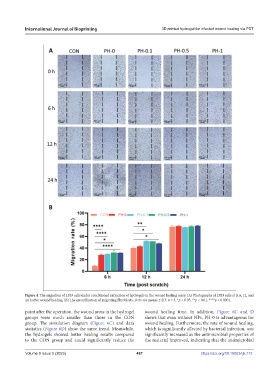Page 475 - IJB-9-5
P. 475
International Journal of Bioprinting 3D printed hydrogel for infected wound healing via PDT
Figure 4. The migration of L929 cells under conditioned extraction of hydrogels in the wound healing assay. (A) Photographs of L929 cells at 0, 6, 12, and
24 h after wound healing. (B) The quantification of migrating fibroblasts. Data are means ± SD; n = 3. *p < 0.05, **p < 0.01, ****p < 0.0001.
point after the operation, the wound areas in the hydrogel wound healing time. In addition, Figure 6C and D
groups were much smaller than those in the CON shows that even without NPs, PH-0 is advantageous for
group. The simulation diagram (Figure 6C) and data wound healing. Furthermore, the rate of wound healing,
statistics (Figure 6D) show the same trend. Meanwhile, which is significantly affected by bacterial infection, was
the hydrogels showed better healing results compared significantly increased as the antimicrobial properties of
to the CON group and could significantly reduce the the material improved, indicating that the antimicrobial
Volume 9 Issue 5 (2023) 467 https://doi.org/10.18063/ijb.773

